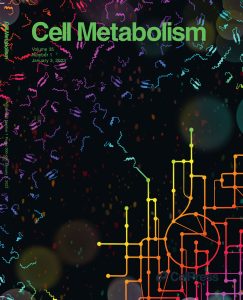
January 3, 2023
Scientists discovered more than 3,800 small proteins involved in metabolism and found that one microprotein, Gm8773, increases feeding activity in mice—providing a potential new approach to encourage weight gain in people with cancer and other diseases
Scientists discovered more than 3,800 small proteins involved in metabolism and found that one microprotein, Gm8773, increases feeding activity in mice—providing a potential new approach to encourage weight gain in people with cancer and other diseases
LA JOLLA—Obesity and metabolic diseases, such as diabetes, are extremely common in the United States. Tiny proteins called microproteins have long been overlooked in research, but new evidence demonstrates that they have an important role in metabolism. Salk scientists have discovered that both brown and white fat is filled with thousands of previously unknown microproteins, and show that one of these microproteins, called Gm8773, can increase appetite in mice.
These findings, published in Cell Metabolism on January 3, 2023, could lead to the development of a therapeutic to help people gain weight in certain disease situations, such as during chemotherapy for cancer. Furthermore, by establishing the existence of these microproteins, the team provides a valuable resource for the scientific community to study microproteins as well.

“It is vital to better understand the processes that regulate obesity and metabolic health in order to provide improved therapies for the future,” says Salk Professor Alan Saghatelian, co-corresponding author of the study and holder of the Dr. Frederik Paulsen Chair. “Having this list of microproteins will aid the field of metabolism in identifying new players in a variety of metabolic diseases. And we’ve demonstrated one biologically active microprotein that promotes feeding, as well as other microproteins that are involved in fat metabolism.”
Fat tissue secretes many different proteins to regulate feeding, energy balance, and the production of heat. White fat, known as “bad fat,” is often found just beneath the skin and in the abdominal region. This type of fat acts as an energy storage depot and is related to obesity and other diseases caused by excess weight. In contrast, brown fat or “good fat” is located around the shoulders and along the spinal cord. Brown fat is associated with proper nutrition, exercise, and health.
In this study, the scientists used innovative genomics technologies to examine the brown, white, and beige fat (another type of fat with features similar to both white and brown fat) in mouse cells. They discovered 3,877 genes that produce microproteins in both white and brown fat. Additionally, they explored the levels of these genes in mice fed a high-fat Western diet, and linked hundreds of microproteins to changes in fat tissue metabolism. Overall, the analysis highlights many likely metabolically relevant microproteins for the first time.
“We’ve provided a roadmap on how to best use our data to link and eventually characterize the roles of microproteins in fundamental metabolic pathways,” says first author Thomas Martinez, a former postdoctoral fellow in Saghatelian’s lab who is now an assistant professor at UC Irvine.

The team also focused in on a microprotein called Gm8773, located in the feeding center of the brain, called the hypothalamus. The location of the microprotein in the brain suggested it may play a role in appetite. Indeed, when the scientists administered Gm8773 to obese mice, the mice consumed more food. There is also a human gene similar to Gm8773 called FAM237B, and this gene could act similarly in humans to promote eating. According to the researchers, this microprotein could eventually be developed into a therapeutic to promote weight gain in those experiencing extreme weight loss.
“The new microproteins presented in our study are exciting discoveries for the field of metabolism and for the study of fat biology,” says co-corresponding author Chris Barnes, formerly of Novo Nordisk Research Center Seattle, Inc., now head of proteomics at Velia Therapeutics. “We hope that this resource will be used to generate numerous new experimental hypotheses for the scientific community to test in their own labs, and that this work leads to the identification of novel mechanisms in biology.”
In the future, the scientists plan to develop tools to investigate the roles of Gm8773 and FAM237B with the goal of eventually developing a therapeutic that can increase appetite in humans.
Other authors include Cynthia Donaldson, Joan M. Vaughan, Calvin Lau, and Maxim N. Shokhirev of Salk; Brian C. Searle of Ohio State University; Lindsay K. Pino and Michael J. MacCoss of the University of Washington; Eduardo V. De Souza, and Cristiano V. Bizarro of the Pontifcia Universidade Catolica do Rio Grande do Sul in Brazil; and Sally Lyons-Abbott, Angie L. Bookout, Ariel Abramov, Arian F. Baquero, Karalee Baquero, Dave Friedrich, Justin Huard, Ray Davis, Bong Kim, Ty Koch, Aaron J. Mercer, Ayesha Misquith, Sara A. Murray, Sakara Perry, Christina Sanford, Alex Simon, Yu Zhang, Garrett Zipp, and Andrew J. Whittle of Novo Nordisk Research Center Seattle, Inc.
The work was supported by the National Institutes of Health (R01 GM133981, P41 GM103533, R24GM141156, U19 AG065156, P30CA014195, R01GM102491, RC2DK129961, and K01CA249038), Frederick Paulsen and the Ferring Foundation, a sponsored research agreement with Novo Nordisk Research Center Seattle, Inc., the National Institute of Science and Technology on Tuberculosis, Brazil (421703-2017-2/17-1265-8/14.2.0914.1), the National Council for Scientific and Technological Development of Brazil (310344/2016-6), and the Coordenação de Aperfeiçoamento de Pessoal de Nível Superior—Brasil.
DOI: 10.1016/j.cmet.2022.12.004
JOURNAL
Cell Metabolism
AUTHORS
Thomas F. Martinez, Sally Lyons-Abbott, Angie L. Bookout, Eduardo V. De Souza, Cynthia Donaldson, Joan M. Vaughan, Calvin Lau, Ariel Abramov, Arian F. Baquero, Karalee Baquero, Dave Friedrich, Justin Huard, Ray Davis, Bong Kim, Ty Koch, Aaron J. Mercer, Ayesha Misquith, Sara A. Murray, Sakara Perry, Lindsay K. Pino, Christina Sanford, Alex Simon, Yu Zhang, Garrett Zipp, Cristiano V. Bizarro, Maxim N. Shokhirev, Andrew J. Whittle, Brian C. Searle, Michael J. MacCoss, Alan Saghatelian, and Christopher A. Barnes
Office of Communications
Tel: (858) 453-4100
press@salk.edu
Unlocking the secrets of life itself is the driving force behind the Salk Institute. Our team of world-class, award-winning scientists pushes the boundaries of knowledge in areas such as neuroscience, cancer research, aging, immunobiology, plant biology, computational biology and more. Founded by Jonas Salk, developer of the first safe and effective polio vaccine, the Institute is an independent, nonprofit research organization and architectural landmark: small by choice, intimate by nature, and fearless in the face of any challenge.